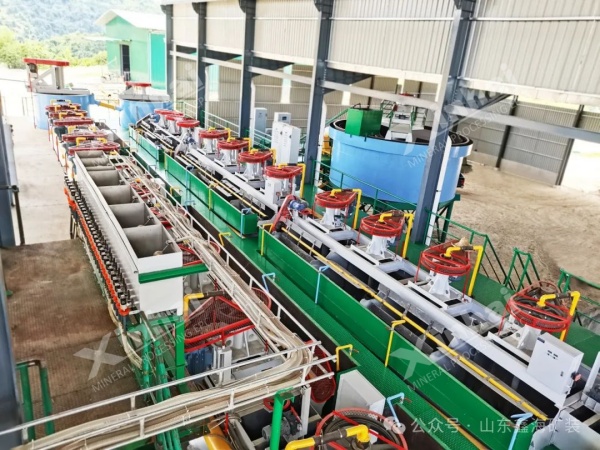If you want to know more information (such as product/process price, etc.), please contact us 24-hour telephone
Aluminum oxide in iron ore concentrates not only reduces the purity of the concentrates but also has a significant adverse impact on the smelting process and the quality of steel products. Therefore, removing aluminum oxide from iron ore concentrates is an essential step in iron ore processing. Several methods are commonly used in production:
1.1 Selective Flotation
Principle: Utilizes fatty acid collectors to selectively adsorb onto iron minerals, while starch and dextrin depressants inhibit aluminum silicate minerals from floating. Separation is achieved at pH 8-10.
Application: This method is effective for separating aluminum from iron, particularly suitable for hematite and magnetite ores.
1.2 Reverse Flotation
Principle: Sulfate-based collectors preferentially capture aluminum minerals, with NaOH adjusting the pulp to pH 11-12 to enhance the negative charge on aluminum oxide particles, improving flotation efficiency.
Application: This method is effective for removing aluminum from iron concentrates, especially when high selectivity is required.
2.1 Sodium Hydroxide Leaching
Process: At 220-250°C and 3-4 MPa, NaOH reacts with aluminum minerals to form soluble sodium aluminate (NaAl(OH)₄), while iron minerals remain stable as hematite.
Advantages: Effective for high-aluminum limonite ores.
2.2 Acid Leaching Process
Process: Hydrochloric acid (concentration 15-20%) selectively dissolves aluminum impurities at 80-90°C, preserving iron minerals as Fe₂O₃. This method is particularly suitable for processing limonite ores with high kaolinite content. Trial data from Vietnam's Thach Khe iron mine showed an Al₂O₃ removal rate of 78% with less than 5% iron loss.
Advantages: Effective for high-kaolinite limonite ores.

Process: High-temperature sintering at 1250-1300°C transforms aluminum oxide into low-melting-point calcium aluminum silicate phases, which are then separated from iron using high-pressure grinding rolls and weak magnetic separation. Tata Steel's sintering-magnetic separation production line in Joda, India, reduced the Al₂O₃/SiO₂ ratio from 0.8 to 0.3, meeting the standards for pellet production.
Advantages: Suitable for ores requiring pre-treatment before further processing.
Process: At 900-1100°C, chlorine gas converts aluminum oxide into volatile AlCl₃ (boiling point 183°C), while iron remains as FeCl₂ and is subsequently reduced and recovered. This process has unique advantages for vanadium-titanium magnetite ores containing titanium and vanadium. Industrial trials by Pangang Group showed an aluminum removal rate exceeding 92%.
Advantages: Effective for ores with associated elements like titanium and vanadium.
Principle: Pulse electric fields control the surface potential of minerals, selectively dissolving aluminum minerals. Quadra Company in Canada developed an electrochemical flotation system that achieved an aluminum removal rate of 65% in a neutral pH 6.5 environment, reducing energy consumption by 30% compared to traditional flotation.
Advantages: Offers a green and energy-efficient alternative.
Process: High-gradient magnetic separators (1.2-1.5T) separate weakly magnetic aluminum-bearing minerals from magnetite-hematite mixed ores. LKAB in Sweden uses multi-stage wet magnetic separation to maintain Al₂O₃ content below 0.9% in iron concentrates, becoming a core supplier of high-end pellet feed in Europe.
Advantages: Effective for ores with distinct magnetic properties.
Technology Selection and EPCM+O Service Value
| Technology Route | Applicable Ore Types | Investment Intensity | Operating Costs | Aluminum Removal Efficiency |
|---|---|---|---|---|
| Flotation Method | Hematite/Magnetite | Medium | Medium | 75-85% |
| Alkaline Leaching | High-Aluminum Limonite | High | High | 80-90% |
| Chlorination Method | Multi-Metal Associated Ores | Extremely High | Extremely High | >90% |
It is recommended to evaluate the best technology combination through a three-stage assessment: mineralogical analysis, laboratory verification, and semi-industrial trials. Our EPCM+O service team can provide:
Customized Process Design: Optimizing process parameters based on MLA mineral liberation analysis.
Reagent System Optimization: Developing composite depressants/capturers to reduce reagent costs by 30%.
Full Lifecycle Management: Comprehensive technical support from engineering design to production operation.
Efficient removal of aluminum oxide is a key step in enhancing the value of iron concentrates. By accurately matching processes and innovating technologies, product premiums can be significantly increased. Please contact our mineral processing engineering center for customized solutions and pilot support.